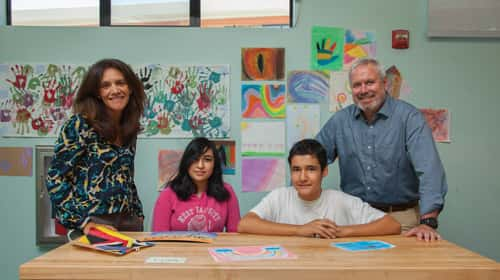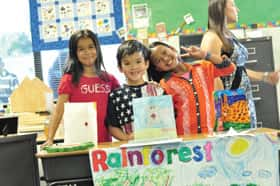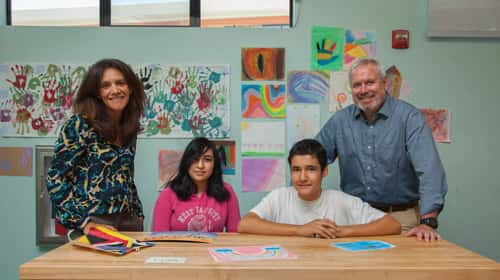 Kids clustered in groups, sharing ideas and discussing issues, is an increasingly common sight in schools these days. It’s project-based learning (PBL) in action, as the orderly rows of neat desks that once defined how children learned make way for new methods in teaching that give students the opportunity to gain skills and knowledge to prepare them for the challenges of life beyond school. It’s a transition that’s reshaping education, and it’s been a long time coming. “School has not changed much over the past 100 years,” says Bob Lenz, executive director of the Buck Institute for Education in Novato. As a former social studies teacher invested in finding the best ways for students to learn, Lenz believes Project Based Learning (PBL) makes a profound difference and welcomes the change. “Project-based learning is a concrete way for kids to learn to live in the world that’s coming,” he says, and his observation comes from a rare perspective. BIE is a world leader in developing the best practices for making PBL effective.
Kids clustered in groups, sharing ideas and discussing issues, is an increasingly common sight in schools these days. It’s project-based learning (PBL) in action, as the orderly rows of neat desks that once defined how children learned make way for new methods in teaching that give students the opportunity to gain skills and knowledge to prepare them for the challenges of life beyond school. It’s a transition that’s reshaping education, and it’s been a long time coming. “School has not changed much over the past 100 years,” says Bob Lenz, executive director of the Buck Institute for Education in Novato. As a former social studies teacher invested in finding the best ways for students to learn, Lenz believes Project Based Learning (PBL) makes a profound difference and welcomes the change. “Project-based learning is a concrete way for kids to learn to live in the world that’s coming,” he says, and his observation comes from a rare perspective. BIE is a world leader in developing the best practices for making PBL effective.
A non-profit institute focused exclusively on teaching and the process of learning is a gift to Marin County that comes from the legacy of philanthropist Beryl Buck. With guaranteed funding from the Buck Trust, BIE got its start in 1987 on a quiet tree-lined street in Bel Marin Keys, and its initial work was research and consideration of general learning. The institute’s first executive director was Carolyn Horan, and the idea was to advance teaching and the process of learning. “A lot of it was just Carolyn pulling everyone together,” says Lenz. Project Based Learning came into the picture in 1997, when BIE published a handbook on PBL and began developing project-based curriculum units for high school economics, then civics and government courses. In 2008, BIE decided to put its emphasis on training teachers in PBL, in the belief that it is one of the best ways for students to learn if they are to be successful in life. After Lenz, who had been on the board since 2001, became executive director in 2015, BIE did a new strategic plan, which maintained its focus on providing support for teachers, but went farther by expanding its services to build the capacity of school leaders to create the conditions for PBL. “That was the strategic shift, working with schools and systems, not just teachers,” says Lenz.
Understanding PBL
 PBL focuses on a deep understanding of content, knowledge and the four Cs: communication, collaboration, creativity and critical thinking, and the way one develops those skills is by doing them. “You cannot learn to collaborate by reading [about] it in a book. You learn to be an effective team member by working in a team,” Lenz observes. “Teachers have to provide the opportunity, and PBL is a great way to do it,” he says, adding that people all over the country are beginning to understand that young people require a new set of skills and understanding, and the Buck Institute’s role is to help educators make the changes that will allow them to meet those needs. He finds that PBL is as beneficial for teachers as it is for their students. “It engages teachers just like it engages kids,” he says. “It brings joy and happiness into the classroom.” In addition, he reports that many teachers say it has helped them rediscover why they went into teaching in the first place—to make a difference in children’s lives.
PBL focuses on a deep understanding of content, knowledge and the four Cs: communication, collaboration, creativity and critical thinking, and the way one develops those skills is by doing them. “You cannot learn to collaborate by reading [about] it in a book. You learn to be an effective team member by working in a team,” Lenz observes. “Teachers have to provide the opportunity, and PBL is a great way to do it,” he says, adding that people all over the country are beginning to understand that young people require a new set of skills and understanding, and the Buck Institute’s role is to help educators make the changes that will allow them to meet those needs. He finds that PBL is as beneficial for teachers as it is for their students. “It engages teachers just like it engages kids,” he says. “It brings joy and happiness into the classroom.” In addition, he reports that many teachers say it has helped them rediscover why they went into teaching in the first place—to make a difference in children’s lives.
The challenge for teachers is to design PBL curriculum that’s meaningful and gives students a deep level of understanding. A project needs to be high quality and intellectually rigorous. It must require critical thinking, making it more than a hands-on activity. For example, all fourth-graders in California study missions, and most of them build a model. Lenz points out, however, that kits are available at craft stores, and while simply assembling a mission might be interesting, it’s not really PBL, because it lacks depth. Instead, he suggests a simulation that takes students back in time to Spanish California, shortly after the 21st and final mission was completed in Sonoma in 1823. They receive a letter from an archbishop who wants to build a 22nd mission, and they have to conduct research and then create proposals for a new religious outpost. Among the decisions they have to make are how big it should be and where to locate it, and when they start, they don’t know that the missions are a certain distance apart for a specific reason. If they’re interested in social justice and equity, they might also find out what the impact might be on indigenous people. When their plans are ready, students present their proposals to an adult playing the role of the archbishop and get feedback.
It’s a major shift for teachers because they’re moving from textbooks to putting students in charge of their learning. To help teachers and administrators acquire the skills to implement PBL successfully, BIE conducts workshops for teachers and leaders around the U.S. It also publishes books and holds conferences nationwide, including PBL World in Napa each June, a highly-regarded annual conference featuring three days of workshops, such as PBL 101, which is considered the gold standard for learning how to implement Project Based Learning. Lenz reports that PBL World 2017 was sold out by the middle of March, and more than 1,200 people will attend from all 50 states and more than 10 different countries, demonstrating the growing interest in PBL
Also in June, BIE and the Marin County Office of Education collaborated to hold the Marin Summer Institute at Walker Creek Ranch, MCOE’s outdoor school in West Marin. It was the third annual conference, and Raquel Rose, assistant superintendent at MCOE, explains that it’s a big draw, because schools throughout the county are interested in implementing PBL. She saw somewhat fewer Marin educators attending this year, but she attributes that to professional development opportunities such as BIE’s PBL 101 and PBL 102, which take place throughout the year and are advantages of MCOE’s relationship with BIE. The drop gave more participants from outside Marin County the opportunity to attend. “We’re still getting a good critical mass,” Rose says.
Rose sees PBL transforming education in several ways. The most obvious changes are in the classroom. “PBL is a strategy approach from my perspective,” she says, explaining that it begins with a driving question that leads to a culminating event. The four Cs are embedded in the project, and subject areas are often integrated, as teachers make sure they meet all the needs of the state framework for curriculum, as well as Common Core requirements. “It’s really a three-ring circus because you’re trying to manage so many things at once, while making sure that kids are learning,” she says. “[However,] the great thing is that you’re hitting all these content areas through an interest area for the kids,” she adds.
The way teachers interact is also undergoing change. In the beginning, PBL was about students collaborating, but over time, teachers realized it was beneficial to collaborate with each other as well. Rose observes that as teachers brainstorm to share thoughts and ideas, they’re able to add components to their projects they might not have thought about working on their own, and that makes their units richer. “Teaching used to be a very isolated profession, but that’s changing. Doors are opening more. Walls are coming down,” she says. It’s a spirit that extends to school districts as well. Rose reports that the Novato Unified School District has a contract with BIE, and when it held several training sessions for administrators, it welcomed educators from other districts too. “They all get to throw their hats in the ring and share the costs and the learning,” she says.
Evolution in learning
Novato began implementing PBL in all grades, kindergarten through 12th grade, four years ago, when the first teachers in the district took PBL 101 and looked at ways to apply BIE’s gold-standard model, reports Julia Kempkey, director of instruction and innovation. “The Buck Institute is a good partner,” says Kempkey, who considers PLB an approach to teaching rather than a one-time experience, with a typical project including six to eight weeks of deep inquiry into a community-based question and a public presentation at the end. Projects put content into context, and the size of projects varies, but the intent of all of them is to engage the students, who complete the unit with something memorable they can be proud of. She explains that a group’s composition might be dependent on a common interest, but it can also be based on the skill set of the students, which makes it a good model for differentiated learning. “It looks at skills, rather than high achiever, low achiever,” she points out, adding that it’s ideal for English learners, because they have to talk in class and use English in conversation. “It’s really powerful for language development,” she says. Projects can range from an elementary-school project that explores ways to reduce waste on campus, with graphs to show how it will impact the community, to an integrated English/history project in high school that examines the history of revolutions and looks at the different ways people resist and revolt. She adds that projects can be challenging for the teacher, however, because they’re so open.
Deep and deeper
Dr. Michael McDowell, superintendent of the Ross School District, served on BIE’s national faculty for several years, helping leaders to consider ways to engage in PBL. He explains that much of its value lies in helping students to transfer learning so they can apply it to the real world. “You don’t see that often in a 20th century model,” he says. “What I think makes PBL so fantastic, kids learn in context and have to use 21st century skills.” However, he adds, it has to be substantial and have depth. “It’s got this very collaborative feel to it, but the challenge is that we need to go deeper than that,” he says. “We want kids to be able to take content and put it to any situation.”
In addition to his administrative tasks, McDowell teaches sixth through eighth grade at Ross School, and he describes a project relating to sea otters, which were hunted almost to extinction by the Russians in early California. On the surface, students were learning about the food chain and food web, so he started with that as surface knowledge on the first day. The project then moved on to sea otters in collaboration with the Marine Mammal Center in the Marin Headlands to give it depth. Each student had a sea mammal patient and received documentation about that particular pinniped, including treatment, observations and a necropsy if the animal didn’t survive. As they delved deeper to find out what had happened to their patients, they learned about topics such as microorganisms and pH levels in the ocean, and that allowed them to look at trends and patterns as they related to the individual patients. That led them to transfer their knowledge to conversations about other issues, such as the environment, global warming, hunting and conservation.
Based on his own experience, McDowell wrote a book, Rigorous PBL by Design, which contains templates that assist teachers in designing meaningful projects, and its intent is to help experienced teachers as well as those who are brand-new make the most of PBL and bridge the gap between their expectations for a project and implementation. “I wrote the book, because there were questions that I wanted answers to as a teacher,” he says.
BIE’s principles focus on K-12 education, but they also apply to higher education, where they take students to more complex explorations and self-assessment. “They’re laying the groundwork for experiential learning or cooperative learning,” says Janet Watson, a Mill Valley educational consultant who works with faculty at the Haas School of Business at the University of California, Berkeley, to assist in designing engagement strategies that will allow instructors to reach students. “I always add the critical thinking piece,” she says, explaining that the purpose is to give students a chance to consider not only what they’re thinking, but why they’re thinking it. She might weave technology into a class on innovation by posting a question on a screen and having students use their cell phones to analyze information in groups or pairs, and then weave their findings into the debrief. It’s the kind of task students will have to do in the workplace after college, and she encourages them to summarize their thoughts, honoring different viewpoints in class, giving them a chance to learn how to communicate in a safe, nurturing environment. “It’s heightened—a bigger, deeper broader attempt,” she says, observing that students should be able to think about their thinking in experiential learning, which is essentially a higher-level version of PBL. “With the Buck Institute, it’s the scaffolding to build on,” she says, explaining that PBL in elementary and high school helps students make the transition into higher learning. “It’s extremely beneficial to early learning that they’re focusing on the K-12 piece. “It’s better to experience the learnings than being told how to think,” she says.
“We applaud Haas for leading the way,” says Lenz, who believes that when students have a chance to use PBL to interact with faculty and prepare for the workplace, a university education becomes more valuable. He gives the example of students in a class at the University of California, Davis, who created a sustainable agriculture project and worked as a team to help unemployed veterans start a farm. He considers it an exemplary project that had seniors demonstrating that they’re ready to take on the world.
Despite its growing popularity and relevance to the greater world, Lenz doesn’t consider PBL new. “It’s been around for a long time. I struggle to think of it as an innovation,” he says, recalling the amazing projects he did with his students at Sir Francis Drake High School in San Anselmo in the 1990s. What is new is a greater sense of urgency and more of a collective understanding that the world has changed dramatically. Life is more complex, people are more connected, and more jobs are automated, so young people need new tools. Innovation, creativity and design are 21st century priorities, and PBL give students an opportunity to develop those skills. “Kids should be doing capstone projects at ever level. They need the complexity and the challenge. It’s what adults do every day,” say Lenz. “More and more people all over the country are coming to this understanding.”
BIE is celebrating its 30th anniversary in 2017, and its impact in making meaningful change in education is something to celebrate. “I see PBL growing dramatically,” says Lenz. “Our vision is that every kid is doing two projects a year across the country.” And he ponders Beryl Buck’s bequest, what it’s allowed BIE to accomplish and how far it’s reached. Says Lenz, “I like to think she’d be pleased to see that her investment in the Buck Institute for Education truly is making a difference in Marin County and for students, teachers and families across the United Stated and beyond.”




